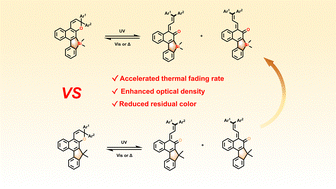Silindeno-fused 3H-naphthopyrans with fast thermal fading rate and high optical density†
Abstract
Photochromic naphthopyran derivatives have been used as important optical functional materials in many fields because of their ideal photosensitivity and good fatigue resistance. However, controlling the thermal fading rate within several seconds while sustaining intense coloration remains a challenge for the practical application of photochromic naphthopyrans. Herein, a series of silindeno-fused 3H-naphthopyrans and their carboindeno-fused analogues are designed and synthesized, and their photochromic properties are investigated via experiments and theoretical calculations. The introduction of a silindene ring can significantly increase the optical density due to their greater molar extinction coefficient. Moreover, the color-fading speed can be controlled to be within several seconds as a result of the introduction of the silindeno-fused ring unit. These compounds exhibit excellent fatigue resistance and thermal stability in the toluene solution and in the polymethyl methacrylate film. This work provides an effective strategy for designing photochromic materials with high-performance.



 Please wait while we load your content...
Please wait while we load your content...